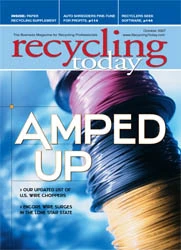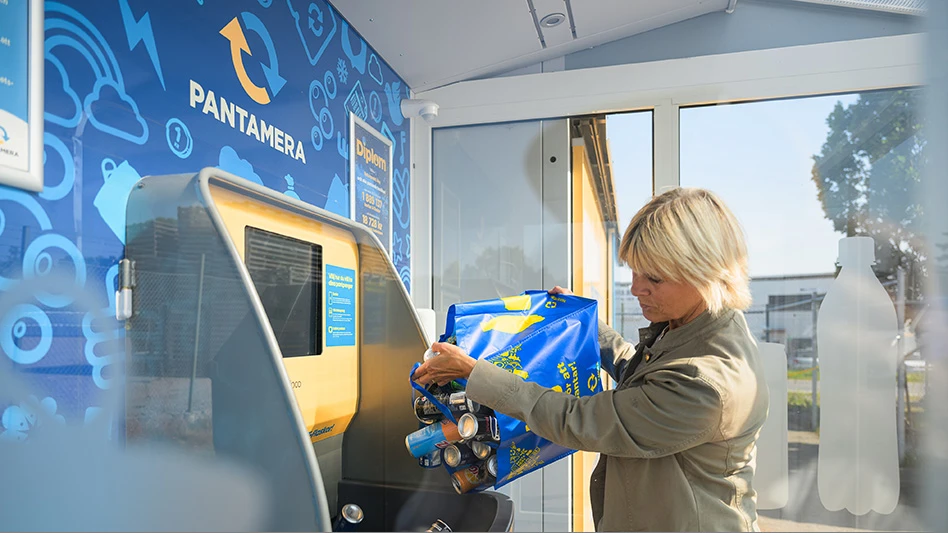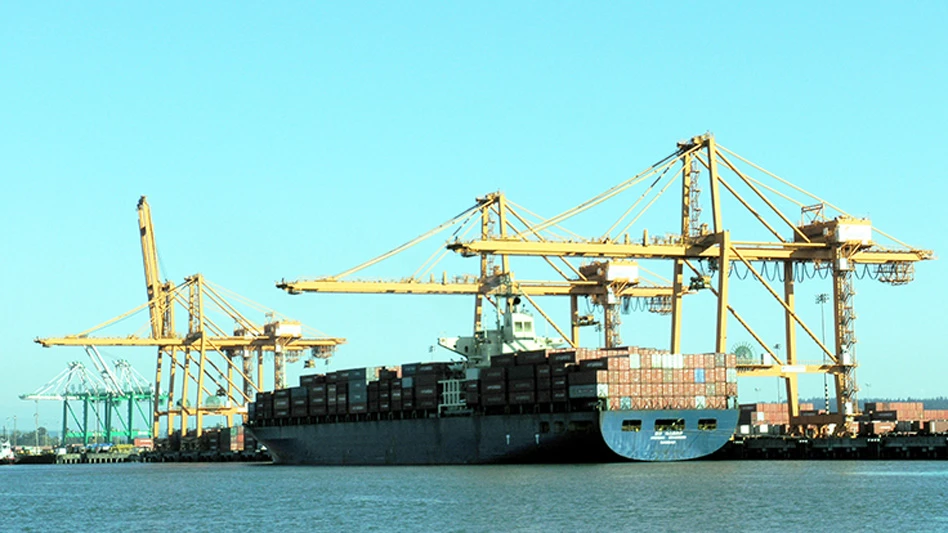Any large business can find itself having difficulty keeping up with its management of logistics. In addition to forming a transportation team and employing new staff, another potential solution is to outsource transportation functions to a firm that has expertise in logistics services.
SP Newsprint Co., Atlanta, uses more than 120 truckloads per day of recovered paper at its Dublin, Ga., mill. With mills in both Dublin and Newberg, Ore., SP Newsprint is one of North America’s leading consumers of old newspapers (ONP).
Pacer Global Logistics, Dublin, Ohio, is a growing North American provider of intermodal and end-to-end supply chain logistics services. Its transportation services include full truckload transportation, rail intermodal marketing services, supply chain management, ocean freight forwarding, warehousing and distribution.
What do the two companies have in common? They are now working together closely to provide SP with an effective supply chain management system.
THE NEED FOR 3PLRalph Simon, vice president of SP Recycling Corp., a division of SP Newsprint, notes that his initial research into SP’s transportation costs led him to consider the company’s overall supply chain. "What a supply chain does is make you think of the process from beginning to the end," says Simon.
He observes that rather than functioning as a smooth circle, SP’s logistics was a series of small chains that weren’t connecting.
To improve its supply chain, SP hired Vic Springer, a paper and logistics industry veteran, as supply chain manager. His role is to help SP connect the dots.
The way SP was doing business included having one group that handled only suppliers and what came into the mill, while another group handled shipments out of the mill, according to Springer. "We did an analysis on what our systems were, what we presently had and how well we were organized," Springer says. "After looking at all this, we realized it was going to be a major expense to upgrade the whole transportation group we had in place."
That’s when Springer suggested outsourcing opportunities.
Manufacturers outsource to a third-party logistics provider (3PL) because they see it as an alternative to devoting time, money or manpower to create a new department within the company to manage transportation. In SP’s case the company was looking for a 3PL to help with several goals: reducing costs, improving service and coordinating activities.
Turning to an outside source, like Pacer, to coordinate things such as warehousing, manufacturing and distribution can save the manufacturer the costly trial-and-error process and instead place transportation in the hands of an expert in the logistics field.
Besides having a previous relationship with Pacer, Springer was also sold on the company’s overall package. "We are still in control of our own freight and decision-making," Springer says. "Pacer is the arm that executes our plan and provides data back to us."
A JOINT SOLUTIONThrough its tools, investments and technology, Pacer matches transportation assets and solutions to the client’s needs, says Tim
|
HAULING IT BACK |
|
Managing supply chain services involves looking at every part of the process from beginning to end, which in SP’s case includes looking at backhauling. When reviewing SP’s backhauling, third-party logistics provider Pacer Global Logistics, Dublin, Ohio, looked at the continuous moves outbound from SP’s suppliers into its Dublin, Ga., mill and how it uses the same trucks back out to end clients, says Tim Donnelly, Pacer’s assistant vice president of supply chain services. With suppliers capable of entering orders on the Web site, SP knows exactly when shipments should arrive and what type of truck should be arriving, so it can coordinate its outbound shipments accordingly, says Vic Springer, SP supply chain manager. This system has also helped SP streamline its backhauling. A few years ago a driver would get up early in the morning and get on the road, with all parties assuming everything would go as planned. Now drivers can call the Pacer customer service line or go online to check if their pickup times have been changed. The system is able to keep suppliers and drivers in the loop as to what is happening. "Drivers now have a quicker turnaround time," Donnelly says. "They are spending more time on the road and less time in the facilities." |
Pacer and SP’s relationship began with a discovery process where information was gathered to determine what SP’s network looked like at the time and what its existing processes and costs were.
Pacer interviewed SP employees, talked to suppliers and met with Simon and his staff to discuss their goals and expectations. The information gathering process took a month to complete, and from there Pacer worked jointly with SP Newsprint to develop a solution.
During the process SP encountered a few obstacles pertaining to the transfer of data between SP’s computer system and the Pacer system.
The change to Pacer’s Web-based system took Stefan Bridges, Pacer’s line manager of supply chain services, and his group six to nine months to complete. During the startup he worked on site at SP, dealing with the technical computer transactions and training employees.
"For SP, I think it was really nice for them to have someone they could reach out and contact if they had a problem or issue," Bridges says. He also says because SP had been operating in a one-on-one business mode for so long, the company was concerned the transition would hurt its customer and supplier base.
To maintain that personal touch and to help explain the changeover to its supplier base, SP asked Bridges and his group train suppliers on the program via phone or on-site visits. The SP group also calls customers on a regular basis to get their feedback on how the new system is working or to see if they have any suggestions to modify the Web site.
THE RESULTSNow that SP and Pacer have been working together for more than a year, SP has seen many benefits, according to Springer. Largely, Pacer has helped the company improve its service to both suppliers and customers.
The relationship has helped SP to have more visibility into the supply chain and to be more proactive in its daily activities, says Springer. The company now knows exactly what it’s receiving, how much it weighs and who is bringing it. "Knowing this information makes it easier to coordinate outbound shipments from the mill," Springer says.
SP has received a lot of positive feedback from the suppliers who provide the company with recovered paper and raw materials. They can easily schedule pickups and access information regarding order entry and shipment deliveries by going to the SP link on the Pacer Web site. "Suppliers enjoy the benefit of being able to go online and schedule a pickup anytime during the day," Bridges says.
Pacer has customized SP’s Web order system to include information regarding weight, grades and commodities. "We wanted to make it so they
|
SETTING UP SHOP |
|
All clients of Pacer Global Logistics, Dublin, Ohio, go through the same process to create an effective logistics solution. Tim Donnelly, Pacer assistant VP of supply chain services, breaks down the steps: 1. Discovery process: Touch-point employee interviews (sales, transportation, shipping/receiving, supplier and accounting) and gap analysis; 2. Solution development process: Collaborative effort for best practices to close gaps, improve network efficiencies and reduce costs; 3. Solution implementation process: Written plan including SOPs (standard operating procedures) and KPIs (key performance indicators); and 4. Operation and measurement process: KPIs used to adjust SOPs, inventory and carrier base and to provide continuous improvement. |
One of the plans Pacer and SP are working on for the future is developing the system so consumers or paper distributors can use it to check on deliveries. Before contracting with Pacer, consumers would call SP’s office for answers, but now all customer service calls are handled by Bridges and his group.
"The benefit is we now have someone they can call who deals directly with the carrier, instead of calling someone in our office who has to put them on hold or call them back," Springer says.
All transportation related questions go directly to an area of the Pacer office where SP-specific account personnel are on duty. Customers with questions pertaining to rescheduling or late shipments can reach Bridges and the rest of the group at any time.
LESSONS LEARNEDIn some ways, the partnership has been a learning experience for both parties. Pacer had never had a client in the recycling industry before SP, and partnering with the newsprint manufacturer has taught Pacer about the uniqueness of the supplier’s role in the recycling industry.
Outsourcing its logistic needs to a third party has given SP an outside perspective on the way it does business. The company is getting new feedback on the interrelation of all parts of its business.
Simon says he has come to visualize the supply chain concept more as a circle than as a chain. Since he now sees it as a loop, he more fully understands how a truck picking up a load of ONP can affect how or when a roll of newsprint goes out from the mill.
When it comes to finding a third-party logistics provider, Springer’s advice to others is to make sure the two company cultures match. He also says that both parties need to be open and honest with one another. "Just like with a marriage," Springer says, "you have to make sure you have the right partner."
The author is an editorial intern with GIE Media Inc. She can be contacted at kmorris@gie.net.

Explore the October 2007 Issue
Check out more from this issue and find your next story to read.
Latest from Recycling Today
- Nucor expects slimmer profits in early 2025
- CP Group announces new senior vice president
- APR publishes Design Guide in French
- AmSty recorded first sales of PolyRenew Styrene in 2024
- PRE says EU’s plastic recycling industry at a breaking point
- Call2Recycle Canada, Staples Professional expand partnership
- Circular Services breaks ground on north Texas MRF
- Tariff uncertainty results in choppy nonferrous scrap flows






